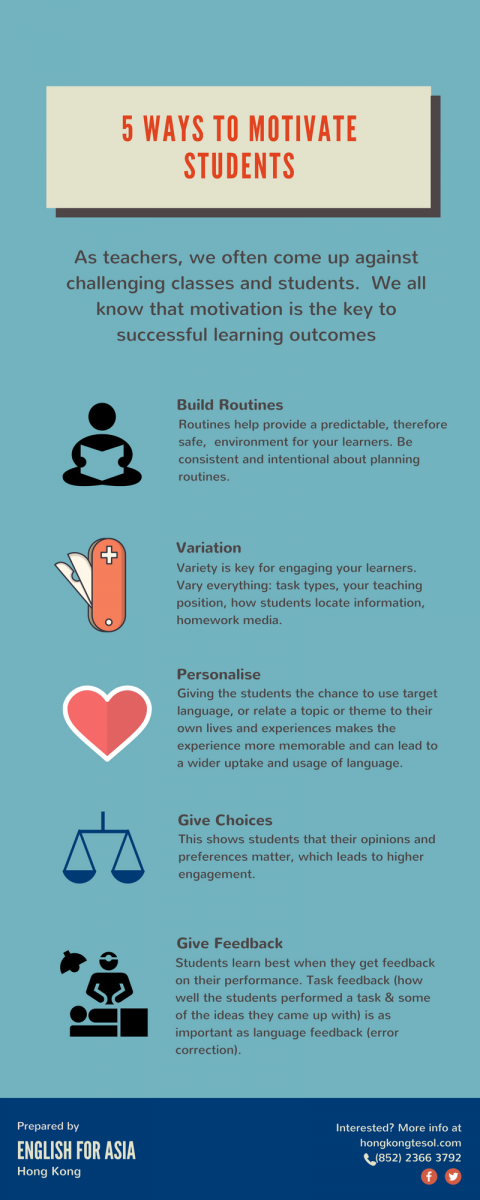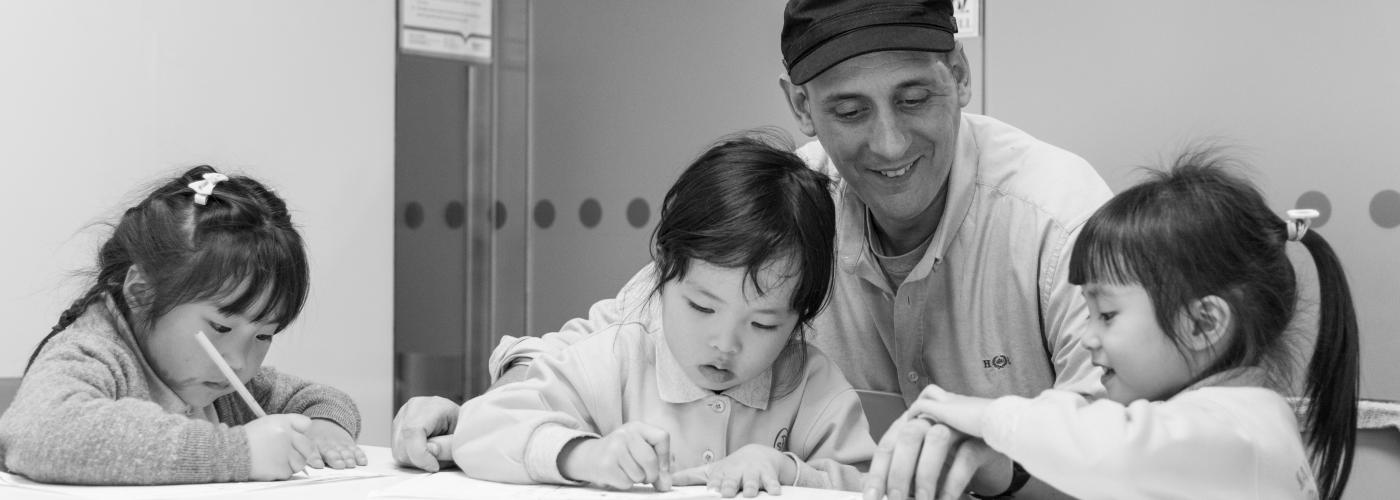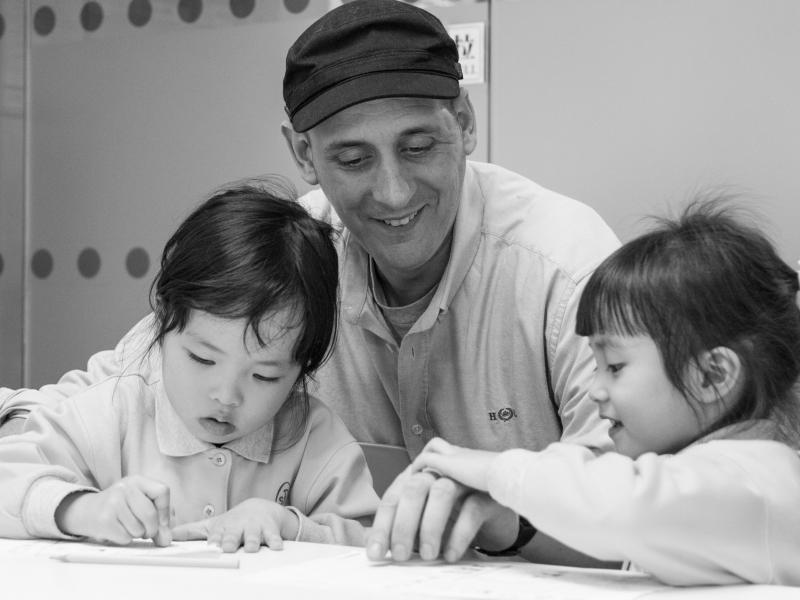21st September 2016
For many of us, our time at school is amongst the most memorable experiences we have of growing up. And for many of us, it’s not just going to school, but the teachers we had that impact us most strongly. And more often than not, it’s the memories of the teachers who motivated us to learn and engage with the lesson that stay with us.
As teachers, we often come up against challenging classes and students. We all know that motivation is the key to successful learning outcomes – in fact I would go further and suggest that if students aren’t motivated, it becomes much harder for them to control their attention, and thus harder to process new information and so they get distracted easily or worse, they may become disruptive.
So here are some suggestions and ideas for staying ahead of the game. If you can keep your students engaged and motivated, the chances are you’ll all leave the classroom feeling satisfied and more productive.
Build routines with your class

Routines are important for many reasons. They make your lessons predictable and can help students to predict what comes next. This in turn can reduce (often unconscious) feelings of anxiety that arise from working in groups or unfamiliar settings. But routines come in many shapes and sizes – what’s important is to be aware, consistent and intentional about the routines you create in your classroom.
Imagine you are a fly on the wall in your classroom. You’re watching the perfect class. Everything is happening smoothly. Students who finish early, walk across to the book box, take a book and read quietly. Students who need help turn to their partner and ask them for assistance before moving across the room to find a dictionary. None of this happens by accident. It’s the result of setting up routines in your classroom, practicing them with the students regularly and rewarding students when they participate.
Remember, everything that happens in a well-polished and efficient classroom happens intentionally. So here are some suggestions.
Entry routines
Before class, how do you allow the students to come into your classroom? Do you leave the door open? Do they walk into the room in lines and sit down in the same seat every week? Do you ask them to meet you in a circle at the front of the room? Why? Setting your expectations about how you want the students to come into class sets the tone for the rest of the lesson….indeed, the rest of the semester. What happens if they come in, shouting and screaming and throwing their bags on the floor? Smile, ask them to leave, and when they are ready, have them try again, in the way you have explained.
Exit routines
Just as it’s important to set the expectations for how the students come into the class, it’s important to maintain these expectations until the very last minute. From a safety perspective, having students leave in an orderly manner can make it much easier to identify which students have been met by parents and guardians, and which students may need your help until their parents arrive.
One of the ways I typically end my lessons is by asking students to write down their record of work and their homework, and then I ask the students if they would like to start their homework first, or if they would like to take a book and spend the final 5 minutes of class reading quietly. They then continue to read until their parents (who have been waiting outside) come to the door. This gives me a chance to have a word to the parents if need be, not just to communicate concerns about the students, but more importantly, to give positive feedback about students who have done particularly well in the lesson.
Movement routines
Something that is often overlooked is the way in which teachers expect students to move around the room, especially when transitioning between activities and tasks. This is perhaps one of the trickier aspects of routines, because many students finish tasks at different points in the lesson, and it can be hard to get everyone’s attention. Two ideas I like to use with my class are:
To finish an activity, I often tap on the board with my pen and chant to my students: pens down, turn around, look at me. Pens down, turn around. Look at me. Pens down, sit on the floor, come to me. Pens down, sit on the floor, come to me.
Actually the best example of this I have seen was in a primary classroom, where the students were doing a spelling test – and as the teacher counted down to the end of the test….5…4…3…2…1… she then shouted JAW! At which point all the students dropped their pens, put their hands above their head, like a shark fin, and chanted Daa da! Daa da! Daa da!. Of course, this was no accident, it was a well-polished, familiar and frequently-practised routine!
To keep my students busy, I often change the point in the room I talk to them, depending on the part of the lesson we are in. When I am giving them instructions, I ask them to come to the front of the room in a huddle. This makes it easier for me to make eye contact with all of them and see who is paying attention. I then ask them to go back to their desks and start their work. When I am giving them feedback, I might ask them to turn around, stay sitting in their chairs and look at the board. Making each stage of my lesson predictable associated with a particular part of the room may also enhance some students’ ability to recognize when they need to pay attention and the kind of information I am about to give them.
Variety
Variety is the spice of life, no? So why would you do the same thing in the same way every day, especially when the attention and engagement of your students is at stake. Some of the ways I try to keep my students engaged through variety include:
-
Varying my position in the room
-
Having students sit in the same seat to begin with, but mixing pairs up during the lesson, before returning to their original seats
-
Changing my name each day by playing with the sounds my name starts with…..so one day I will be James, the next day I will be Splames (and we’ll talk about splitting in a splircle, and writing down the splomework, or going to the sploilet)
-
Using background music as students are working on tasks or doing speaking activities
-
Asking students to nominate who they would like to give the next answer during feedback
-
Hiding comprehension questions around the room (On the clock, under chairs, in the corner of the board, on the door handle) for students to find and dictate to each other before reading or speaking tasks
-
Asking students to stand in a line according to age, height, arm length, hair length, month of birth…and then regrouping them according to who they are standing next to.
-
Why not vary the homework tasks you set them by varying the medium, task type or choice they get about homework tasks. You could try encouraging them to watch videos to learn English for example?
I know, having just talked about routines, and how predictability is important, this might sound contradictory, however keep in mind that many of the routines we talked about above occur during key stages of the lesson…especially points in the lesson that influence important stages and work that comes later.
Personalise
A core concept of all language learning lessons is personalization: giving the students the chance to use target language, or relate a topic or theme to their own lives and experiences. While many people save this part of the lesson for the final stages, it might be more effective if used throughout the lesson.
This is particularly true of younger learners who often experience new things in terms of experiences that have had – lots of young learner teachers will tell you about the stories their students tell them, regardless of the time or stage in the lesson.
My advice is to exploit this where you can. So next time your students offer you a story, or an opinion, why not reply with one of the following:
- Really? Why?
- I wonder what ______ would have said?
- Do you think that was the right thing to do?
- I wonder if you would do the same thing today?
- What happened next?
- That’s interesting. What did you say?
Give them choices
Along with the notion that predictability helps to build a sense of familiarity and a sense of control in the classroom, so does a students’ perception of their own agency. That is to say, their perception of how much their opinions and preference matter.
This can be a challenging concept for many teachers who have a curriculum, tasks, activities, worksheets, tests, coursebooks, target language, a lunch break and demanding parents to satisfy. But there are many ways in which you can offer students choices and still achieve the objectives of your lesson – one of the ways to do this is to give your students forced choices. This means give the students a choice of two or three options.
Why not try some of these:
-
Ask your students which book they’d like to read tomorrow.
-
Ask your students which page they’d like to do for homework (e.g. page 94 OR page 95).
-
Ask the students which role they would like to take for a group project (e.g. researcher, editor, writer etc).
-
Ask students who they would like to work with or sit next two for a particular task.
-
Ask students how they would like to complete a task (by writing, performing describing etc)
-
Ask students which of two different worksheets they would like to use (one with a blank box for writing, the other with more support/sentence stems to give them ideas)
-
Give students a choice of two topics to write about or talk about
-
Ask students which activity they would like to do first (e.g. an activity station lesson)
Give them feedback
At the end of the day, students are in your lesson to learn language. We know that students learn best when they get feedback on their performance, but how much feedback do they need? And what type of feedback is best?
Something that is often overlooked is the importance of task feedback (i.e. how well the students performed a task and some of the ideas they came up with) vs language feedback (often called error correction and reformulation).
Task feedback is often important in the sense that it gives you the chance to respond to what the students are saying, as people. So next time your students tell you ah teacher this weekend, very bad. My grandmother ill, and she die, you might not turn around and say died….she died…everyone…died, repeat after me…
According to some studies, students learn best when feedback is given 50% of the time, rather than conventional wisdom of 100% of the time – this might be because it allows the learners to process the information and adapt their own performance accordingly, without always relying on the teacher. But either way, it is undeniable that students expect errors correction, they want it from you, and it’s very much a part of your role as a language teacher. So why not keep them on their toes with some of these ideas:
-
Print corrections out and pin them around the room for learners to find when they finish a task
-
Tape different answers to each table and have students move around the room and share their answers
-
Divide the board in two columns: Answers we are sure about, and Answers we aren’t sure about. Let the class decide where to put their answers before you give feedback.
-
Use sticky notes to write corrections as students work and stick them on their desks to be checked at the end of the lesson
-
Write feedback on sticky notes and stick them all on the whiteboard at the end of the lesson for learners to task and correct as they need
-
Prepare paper strips of errors for learners to correct in races/teams
-
Stick corrections on the board in a grid, like Jeorpardy, and have students choose pieces of paper to turn over and correct in teams - you could also hide a “bomb” under one piece that wipes out a team’s score if they uncover it!



